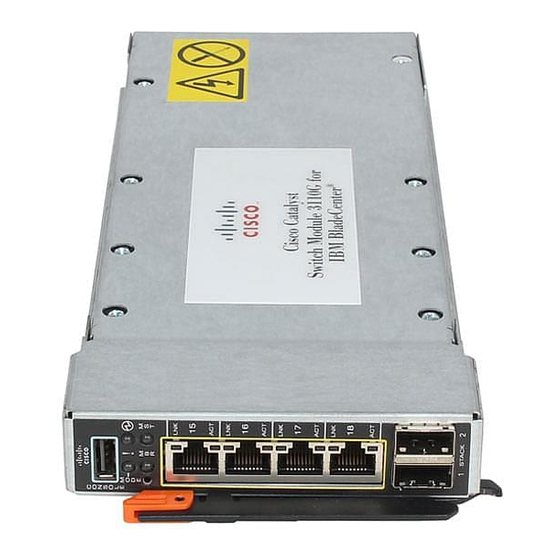Cisco Catalyst 3110G Manuel complémentaire - Page 5
Parcourez en ligne ou téléchargez le pdf Manuel complémentaire pour {nom_de_la_catégorie} Cisco Catalyst 3110G. Cisco Catalyst 3110G 20 pages. Catalyst switch module for ibm bladecenter
Également pour Cisco Catalyst 3110G : Manuel de démarrage (31 pages), Manuel d'installation du matériel (48 pages)

Availability and redundancy
Hot Standby Routing Protocol (HSRP) for Layer 3 router redundancy.
Automatic stack master failover for replacing failed stack masters.
Cross-stack EtherChannel for providing redundant links across switch stack.
Link state tracking to mirror the state of the external ports on the internal Ethernet links and to
allow the failover of the processor blade traffic to an operational external link on a separate Cisco
Ethernet switch.
Configurable Unidirectional link detection (UDLD) for detecting and disabling unidirectional links.
This feature prevents a larger network failure in the event that a unidirectional link is detected,
thus reducing downtime in these situations.
IEEE 802.1D Spanning Tree Protocol (STP) for redundant backbone connections and loop-free
networks.
IEEE 802.1s Multiple STP (MSTP) for grouping VLANs into a spanning-tree instance, and
provided for multiple forwarding paths for data traffic and load balancing.
IEEE 802.1w Rapid STP (RSTP) for rapid convergence of the spanning tree by immediately
transitioning root and designated ports to the converting state.
Optional spanning-tree features available in the PVST+, rapid PVST+, and MSTP modes.
Flex Link Layer 2 interfaces to back up one another as an alternative to STP for basic link
redundancy.
VLAN support
Support for 1005 total VLANs. These VLANs can be any VLAN ID from 1–4094, except 1001–
1005, which are reserved by Cisco.
Cisco Inter-Switch Link (ISL) and IEEE 802.1Q trunking protocol on all ports for network moves,
adds, and changes; management and control of broadcast and multicast traffic; and network
security by establishing VLAN groups for high-security users and network resources.
VLAN Query Protocol (VQP) for dynamic VLAN membership.
VLAN Trunking Protocol (VTP) pruning for reducing network traffic by restricting flooded traffic to
links destined for stations receiving the traffic.
Dynamic Trunking Protocol (DTP) for negotiating trunking on a link between two devices and for
negotiating the type of trunking encapsulation (802.1Q) to be used.
Voice VLAN for creating subnets for voice traffic from Cisco IP phones.
VLAN 1 minimization to reduce the risk of spanning-tree loops or storms by enabling VLAN 1 to
be disabled on any individual VLAN trunk link. With this feature enabled, no user traffic is sent or
received. The switch CPU continues to send and receive control protocol frames.
Private VLANs to address VLAN scalability issues.
VLAN Flex Link Load Balancing to provide Layer 2 link redundancy without STP.
Support for up to 128 instances of spanning tree per switch or per switch stack.
Security
Bridge protocol data unit (BPDU) guard for shutting down a Port Fast-configured port when an
invalid configuration occurs.
Protected port option for restricting the forwarding of traffic to designated ports on the same
switch.
Cisco Catalyst Switch Modules 3110G and 3110X for IBM BladeCenter
5
